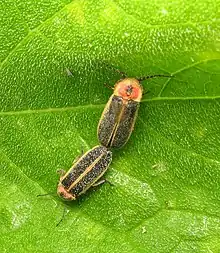Photinus (beetle)
The rover fireflies (Photinus) are a genus of fireflies (family Lampyridae). They are the type genus of tribe Photinini in subfamily Lampyrinae. This genus contains, for example, the common eastern firefly (P. pyralis), the most common species of firefly in North America.
| Photinus | |
|---|---|
.jpg.webp) | |
| Eastern Firefly, Photinus pyralis | |
| Scientific classification | |
| Domain: | Eukaryota |
| Kingdom: | Animalia |
| Phylum: | Arthropoda |
| Class: | Insecta |
| Order: | Coleoptera |
| Family: | Lampyridae |
| Subfamily: | Lampyrinae |
| Tribe: | Photinini |
| Genus: | Photinus Laporte, 1833 |
| Species | |
|
Numerous, see text | |

Male Photinus beetles emit a flashing light pattern to signal for females. Illegitimate receivers, such as female Photuris beetles, identify these signals and use them to locate the male Photinus, attract them with deceptive signals, and eat them. An important study on the diversity of species in the USA and their visual communication was by Lloyd (1966) [1]
Systematics
The closest living relative of the rover fireflies is not yet determined with certainty. In morphology, they resemble their predators, the Photurinae, but they are quite certainly not at all closely related as fireflies go. Rather, the genus Ellychnia is either the closest relative of Photinus, or might even be included in it. Ellychnia are notable for having lost the ability to produce light again, and like the ancestors of all fireflies, communicate with pheromones only. It might thus be warranted to remove some species from Photinus and assign them different genera.[2]
The genus Pyropyga is also a close relative, though it is certainly not as close as Ellychnia. This group makes up the core of the tribe Photinini, and in fact it seems warranted to restrict the tribe to these genera, but more research is still needed, in particular with regard to Photinus and Ellychnia, as the relationship of their type species ("Photinus pallens" and Ellychnia corrusca) remains completely unknown, with the latter also suspected to be a cryptic species complex. Tropical species of Photinus are also not well studied.[2]
Selected species
- Photinus australis Green, 1956[3]
- Photinus carolinus Green, 1956[3] [noted for synchronous flashing]
- Photinus concisus Lloyd, 1968
- Photinus consanguineus LeConte, 1852[4]
- Photinus consimilis Green, 1956[3]
- Photinus floridanus Fall, 1927
- Photinus fuscus (Germar, 1824)
- Photinus harveyi Buck, 1947[5]
- Photinus macdermotti Lloyd, 1966
- Photinus pallens (Fabricius, 1798)[6] – Jamaican Firefly
- Photinus punctulatus LeConte, 1852
- Photinus pyralis (Linnaeus, 1767) – Common eastern firefly, big dipper firefly)
- Photinus tanytoxis Lloyd, 1966
See also
References
- Lloyd, J.E. (1966). "Studies on the Flash Communication System in Photinus Fireflies". Miscellaneous publications (University of Michigan. Museum of Zoology) (130): 1–95.
- Stanger-Hall et al. (2007)
- Green, J.W. (1956). "Revision of the Nearctic species of Photinus (Lampyridae: Coleoptera)" (PDF). Proceedings of the California Academy of Sciences. Fourth. 28 (15): 561–613. ISSN 0068-547X.
- "Photinus consanguineus Report". Integrated Taxonomic Information System (ITIS). Retrieved 2018-01-18.
- "Photinus harveyi Buck, 1947". Smithsonian Institution. Retrieved 2014-12-03.
- Originally described as Lampyris pullens, a nomen oblitum
Further reading
- Stanger-Hall, Kathrin F.; Lloyd, James E.; Hillis, David M. (2007). "Phylogeny of North American fireflies (Coleoptera: Lampyridae): Implications for the evolution of light signals". Mol. Phylogenet. Evol. 45 (1): 33–49. doi:10.1016/j.ympev.2007.05.013. PMID 17644427.